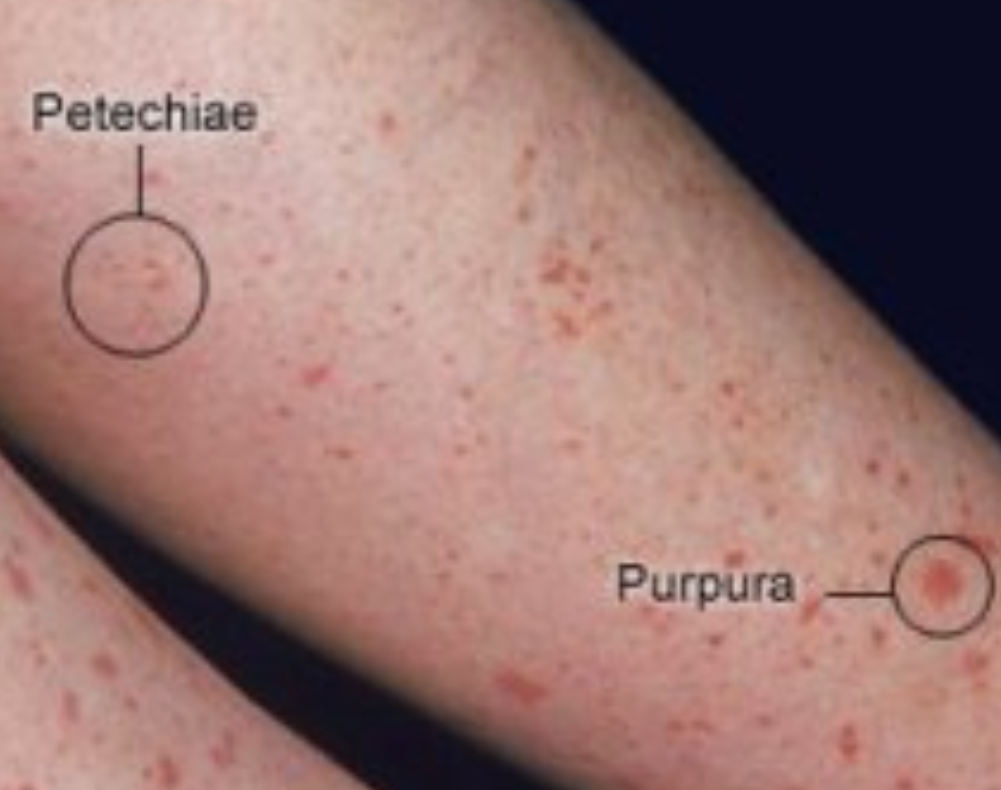Purpura refers to the appearance of red or purple spots on the skin that do not blanch (turn white) when pressure is applied. These spots are caused by bleeding underneath the skin due to the rupture of small blood vessels (capillaries). Purpura can vary in size and may be a sign of various underlying conditions, ranging from benign to serious.
Types of Purpura:
-
Petechiae:
- Small, pinpoint-sized purpuric spots (less than 3 mm in diameter).
- Often associated with minor trauma, infections, or platelet disorders.
-
Ecchymoses:
- Larger purpuric spots (greater than 1 cm in diameter), often referred to as bruises.
- Typically caused by trauma but can also be due to coagulation disorders.
-
Palpable Purpura:
- Raised purpuric lesions that can be felt when touched.
- Often associated with vasculitis, where inflammation of blood vessels leads to leakage of blood into the skin.
Causes of Purpura:
-
Vascular Causes:
- Vasculitis: Inflammation of blood vessels, as seen in conditions like Henoch-Schönlein purpura (HSP) or systemic vasculitis.
- Scurvy: Vitamin C deficiency leading to weakened blood vessels.
-
Platelet Disorders:
- Thrombocytopenia: Low platelet count, which can be due to conditions like immune thrombocytopenic purpura (ITP), bone marrow disorders, or certain medications.
- Platelet Dysfunction: Even with a normal platelet count, dysfunctional platelets can lead to purpura.
-
Coagulation Disorders:
- Hemophilia: A genetic disorder leading to deficient clotting factors.
- Disseminated Intravascular Coagulation (DIC): A serious condition where widespread clotting and bleeding occur simultaneously.
-
Infections:
- Meningococcemia: A severe bacterial infection that can cause purpura fulminans, a life-threatening condition with widespread purpura.
- Viral Infections: Such as dengue fever, which can cause petechiae and purpura.
-
Medications:
- Certain medications, such as anticoagulants (e.g., warfarin), antiplatelet drugs, or corticosteroids, can increase the risk of purpura.
-
Other Causes:
- Senile Purpura: Common in elderly individuals due to fragile blood vessels and thinning skin.
- Amyloidosis: A condition where abnormal protein deposits can weaken blood vessels.
Diagnosis:
- Clinical Examination: The appearance, size, and distribution of purpura can provide clues to the underlying cause.
- Blood Tests: Including complete blood count (CBC), coagulation profile, and platelet function tests.
- Skin Biopsy: May be performed to examine the blood vessels and surrounding tissue, especially in cases of suspected vasculitis.
- Imaging: In some cases, imaging studies may be needed to assess internal bleeding or organ involvement.
Treatment:
- Addressing the Underlying Cause: Treatment depends on the underlying condition causing purpura.
- Vasculitis: May require corticosteroids or other immunosuppressive medications.
- Thrombocytopenia: Treatment may include platelet transfusions, immunoglobulins, or medications to increase platelet production.
- Coagulation Disorders: Replacement of deficient clotting factors or anticoagulation therapy adjustment.
- Supportive Care: In cases of trauma or minor causes, supportive care such as rest and protection of the affected area may be sufficient.
Prognosis:
The prognosis of purpura depends on the underlying cause. While some causes are benign and self-limiting, others may require urgent medical attention and treatment.
